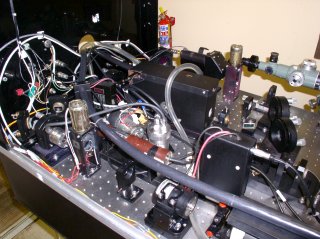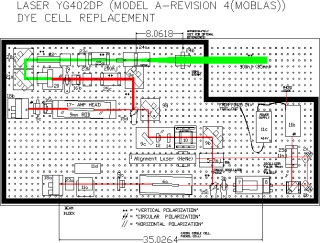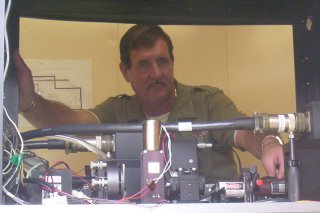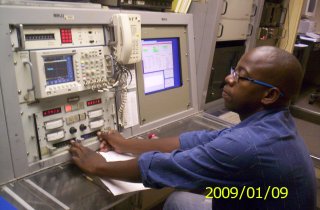
HartRAO Home >
news >
MOBLAS-6 SLR Upgrade 2008/10/31
MOBLAS-6 Satellite Laser Ranger Upgrade 2008/10/31
The NASA MOBLAS-6 Satellite Laser Ranger (SLR) is operated by HartRAO to obtain
precise measurements of the orbits of selected satellites. During 2008
October the laser system received a major upgrade.

Left click on image for large version.
The upgrade team from left to right are:
Standing - Sammy Tshefu (operator), Luzuko
Futwa (operator), Andre van der Merwe (Machine Shop), Johan Bernhardt (SLR
manager), Christina Langa (student and operator) and Willy Moralo (SLR supervisor
and operator); in front - Thomas Oldham from the USA (laser expert
contracted by NASA).
The main objective with this upgrade was to replace the old problematic dye
configuration (Q-switched dye in chlorobenzene solution pumped through a dye
cell in the laser oscillator cavity) with a CR4 Saturable Absorber (a
special doped crystal manufactured for Nd:Yag 1032 nm Q-switched mode
locking).

Left click on image for large version.
Picture of old laser table layout showing the Dye Cell, Dye Reservoir and
Dye Pump (the three stainless steel components).
The problem with the old configuration was that the dye concentrate weakens
over time and the laser oscillator then became unstable and weak in output
power or even fails to lase; it required frequent maintenance and a need
to adjust the dye concentrate on a weekly basis to maintain operation.

Left click on image for large version.
The upgraded laser layout.

Left click on image for large version.
MOBLAS-6 upgraded laser table layout.
Red: 1064 nm infrared
generated by the laser (not
visible to the human eye);
Green: 532 nm visible light, produced by
the frequency doubler from the infrared, that is fired in pulses at
the satellite.
The upgrade was also used as an opportunity to do detail inspection, repair
and service on all optical components used in the laser system to the extent
that we had to remove all the optics from the laser table. The laser table
layout was also affected by this upgrade and in short we basically had to
rebuild the laser from scratch again.

Left click on image for large version.
Oscillogram: Laser output pulse response time
Post upgrade tests revealed that MOBLAS-6 laser system is performing much
better in terms of laser beam quality and stability and requires less
maintenance.

Left click on image for large version.
Johan Bernhardt carries out minor adjustment on the laser.

Left click on image for large version.
Luzuko Futwa tracking satellites with normal ambient light using the new Digital
Phosphor Oscilloscope.
We have also replaced the old CRT tracking oscilloscope with a modern
digital phosphor scope. Now for the first time we are able to track with the operator working in
normal ambient light, where before we needed to turn all the lights off at the
control desk in order to monitor the satellite return signal on the old
analogue oscilloscope.
This was a problem during daytime tracking since the operator's eyes need
time to adjust each time he or she leaves the dark control area to make an
adjustment outside at the telescope for calibration purposes.

Left click on image for large version.
Sammy Tshefu adjusts the translator for infinity focus for
satellite ranging.
The laser is transmitted through the port just below his
hand. The reflected pulse is received by the large telescope to the left;
this has black baffles to minimise light entry from unwanted sources.

Left click on image for large version.
A new meteorological system was installed during the upgrade.
Weather parameters are recorded to assist in compensating the effects of
changing weather conditions on the laser light travel time.









